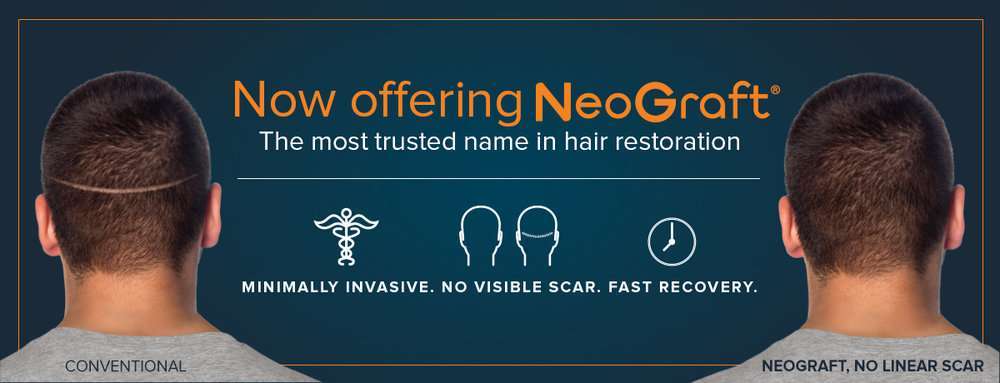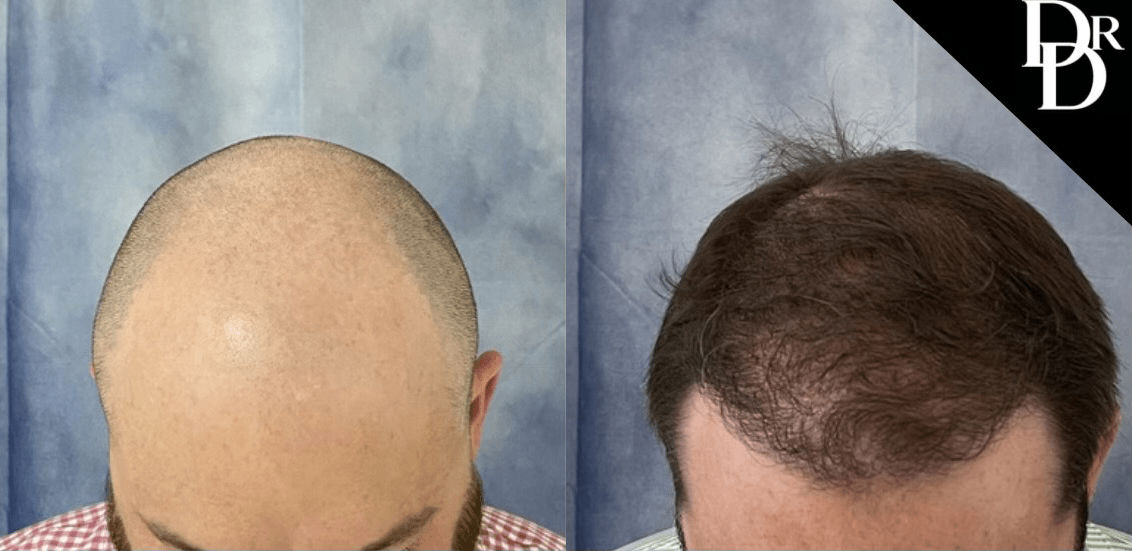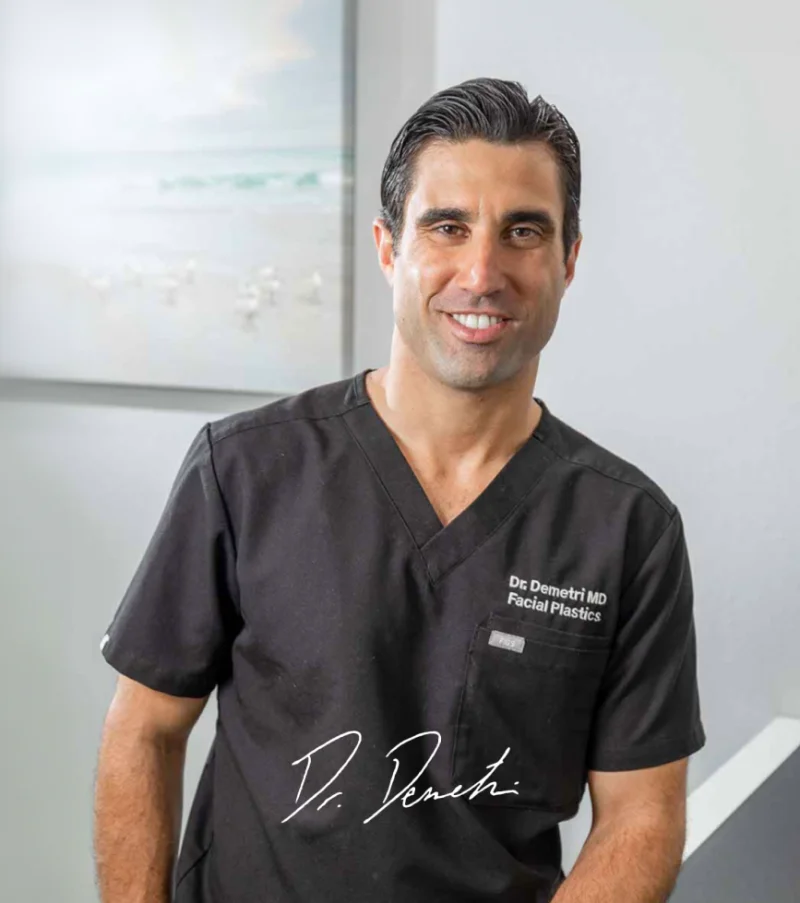Imagine a Restored Hairline with No Linear Scar with a Hair Transplant
Hair thinning is a common occurrence in both men and women. It can occur at any age and is often a source of embarrassment. In the U.S., approximately 50 million men and about 30 million women suffer from male/female pattern baldness. Many of these people often seek hair loss solutions that can help reclaim their hair and the confidence that comes with it. Over the years, technological advances have brought many improvements to hair restoration procedures. Dr. Demetri is proud to offer follicular unit extraction, the latest in hair restoration technology.

What is a Follicular Unit Extraction (FUE) Hair Transplant?
Hair transplants are surgeries that involve harvesting hair follicles from one part of the scalp and implanting them into areas that are thinning. Follicular unit extraction (FUE) is a method in which individual hair follicles are removed manually. Our expert team uses the latest technology that makes the procedure much easier to perform with less discomfort to the patient.
How Much Does a Hair Transplant Cost?
The cost of a hair transplant varies from patient to patient and depends on the needs of each individual. Factors we take into consideration are the extent of hair loss and the number of follicles that need to be removed to achieve the desired results. Dr. Demetri will develop a treatment plan to address your specific needs and discuss the associated cost. We also have affordable financing options through CareCredit.
Is a Hair Transplant Right for You?
Men and women dealing with hair thinning and baldness but have thick hair in other areas may opt for a hair transplant. Candidates should not be experiencing hair loss as a result of medication or stress. During a consultation, we will perform an initial examination and discuss your medical history to determine if FUE hair restoration is right for you.
The best candidates are people with enough healthy hair for transplant. Previous patients of strip grafting can also choose to undergo a FUE hair transplant treatment for better results.
FUE hair restoration treatment is also a good choice for people who prefer to avoid a horizontal incision from traditional hair grafting. In this method, we use tiny punch incisions that are ideal for candidates who want to have a shorter treatment schedule.
The results from a FUE hair restoration are perfect for candidates who prefer a more natural look. The quick recovery also allows the patient to work the next day.

Your Consultation
Your hair transplant consultation will involve an assessment of your existing hair condition. Dr. Demetri will locate good donor sites and recommend transplant sites according to your appearance goals.
During a consultation, Dr. Demetri will give you an overview of your treatment schedule and how to prepare for the procedure.
Be ready to provide your complete medical history to help Dr. Demetri plan a safe and successful treatment to help you achieve a full head of hair.
How to Prepare for a Hair Transplant
Before your appointment, you will need to cut your hair shorter. This will help Dr. Demetri and our expert hair technicians shave the donor site easily for a smooth follicular unit extraction process.
The haircut will also help conceal the changes from the procedure. Patients with longer hair will be shaved strategically to disguise the shaved areas.
The FUE Hair Transplantation Procedure
The first part of the procedure is the hair harvesting. During this portion, we precisely extra hair follicles from the back of your head. They are then examined to ensure their health. After the appropriate number of hair follicles are harvested, we then create tiny recipient sites to the areas of hair loss that bother you. After the sites are created, we then manually transplant each follicle into the sites one by one. It is a tedious process but our experts work tirelessly to ensure it is a smooth and effective procedure for you.
Contact Our Office
Dr. Demetri is a highly skilled, board-certified facial plastic surgeon who is dedicated to helping his patients look their best and restore their confidence through innovative surgical procedures. If you’re interested in learning more about NeoGraft, contact our office to schedule your consultation today.
“I am very happy with the results”
“Great doctor. I felt comfortable talking to him. Everything was straight forward and went exactly like he explained it. I am very happy with the results. I would recommend Dr. Demetri to a friend.”
– A. R.
FAQs: Hair Transplant
Why Am I So Itchy After Getting a Hair Transplant?
Itching after a hair transplant is a common side effect and is usually a sign of healing. The itching can be caused by several factors, including the formation of scabs around the transplanted hair follicles, the growth of new hair, and the healing process of the donor and recipient areas. It’s important not to scratch the itchy areas to avoid damaging the new grafts and interfering with the healing process. Your surgeon may recommend using a mild moisturizer or prescribed medication to alleviate the itching.
Can I Wash My Hair After Getting a Hair Transplant?
Yes, you can wash your hair after a hair transplant, but it’s crucial to follow your surgeon’s specific instructions to ensure proper healing and care of the transplanted area. During the initial washing, it’s important to avoid rubbing or scratching the scalp. Instead, use a gentle patting motion to clean the area. Your surgeon will provide detailed guidelines on when and how to wash your hair to protect the newly transplanted grafts.
How Long Does It Take to See the Final Results Of A Hair Transplant?
The results of a hair transplant can take several months to become fully visible. Initially, transplanted hair will fall out within the first few weeks, a normal part of the process known as “shock loss.” New hair growth typically starts around three to four months post-surgery. Significant improvements are usually noticeable by six months, but it can take 12 to 18 months to see the full and results as the hair continues to grow and thicken over time.
Can The Transplanted Hair Be Styled and Treated Like Natural Hair?
Yes, transplanted hair can be styled and treated just like your natural hair once it has fully grown in and healed. This includes cutting, coloring, and using styling products. However, it’s important to follow your surgeon’s post-operative care instructions and wait until the scalp has healed completely before applying any chemicals or excessive styling.
Are There Any Non-Surgical Alternatives to A Hair Transplant for Hair Restoration?
Yes, there are several non-surgical alternatives to hair transplants for hair restoration, including:
- Medications: Minoxidil (Rogaine) and finasteride (Propecia) are FDA-approved treatments that can help slow hair loss and promote hair regrowth.
- Laser Therapy: Low-level laser therapy (LLLT) can stimulate hair follicles and promote hair growth.
- Platelet-Rich Plasma (PRP) Therapy: This involves injecting your own concentrated platelets into the scalp to stimulate hair growth.
- Scalp Micropigmentation: A cosmetic procedure that tattoos tiny dots on the scalp to mimic the appearance of hair follicles and create the illusion of thicker hair.
Are The Results of a Hair Transplant Permanent?
The results of a hair transplant are generally considered permanent. However, it’s important to note that while the transplanted hair will continue to grow, natural hair around the transplant area may still be susceptible to thinning or loss over time.
Are There Any Age Restrictions for Getting a Hair Transplant?
There are no specific age restrictions for getting a hair transplant, but the ideal candidates are usually those who are in their late twenties or older. Younger patients may still be experiencing active hair loss, making it difficult to predict the future pattern of balding. It’s essential for candidates to have a stable hair loss pattern for the best results.
Can Body Hair Be Used for Hair Transplantation?
Yes, body hair can be used for hair transplantation in certain cases, especially when there is insufficient donor hair available on the scalp. This technique, known as Body Hair Transplantation (BHT), involves harvesting hair from other parts of the body, such as the chest, back, or beard. Body hair typically has different characteristics than scalp hair, such as texture and growth rate, so it may not always be suitable for all patients or desired outcomes.



